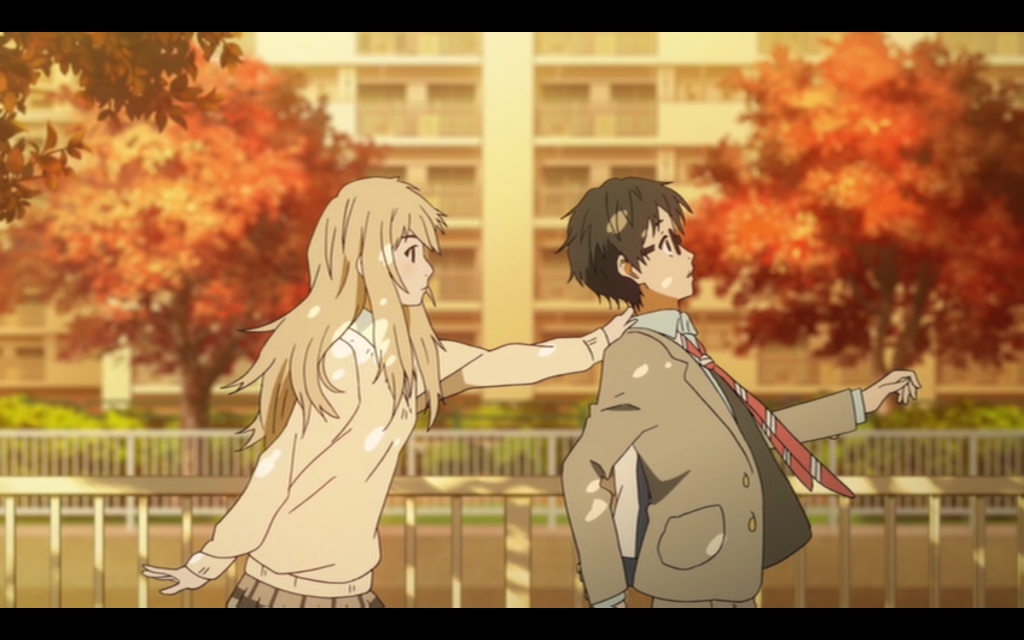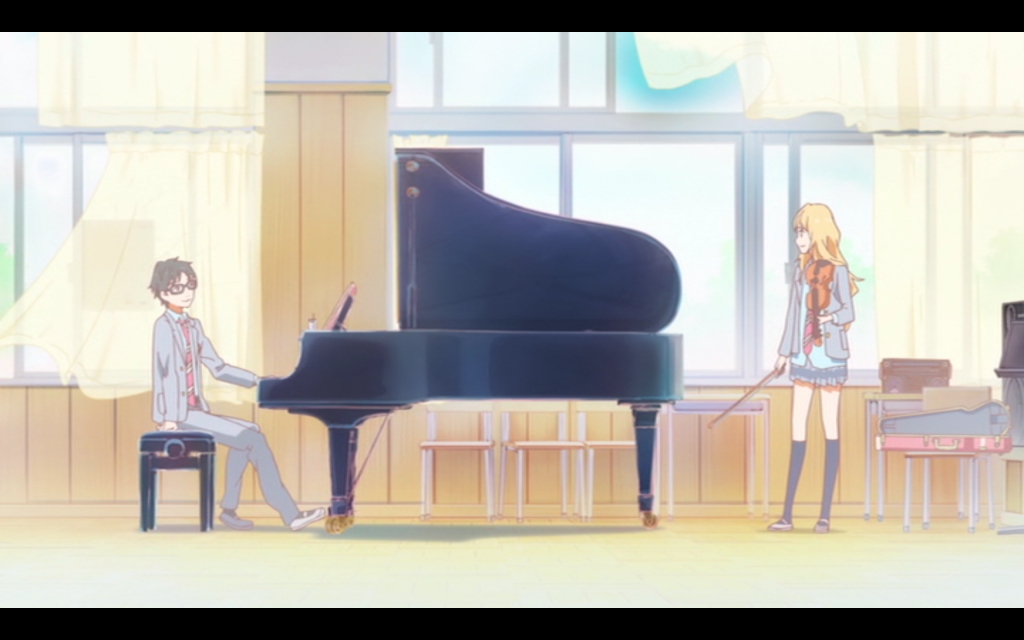Your Lie in April Part 2 Review

“Playing for someone else is more important than you’d think. You said you started playing the piano for someone else, right? That’s when you’re able to play well. When you’ve shared those sounds with tons of people, when you’ve reached tons of people with those sounds, when your hearts come together… it might be that music transcends words.” – Kosei Arima
When I finished reviewing the first part of Your Lie in April back in November 2016, I was left eager to see the series through to the end and experience the second half all over again. It has been a long wait, due to a couple of delays with the UK release, but finally I’ve been able to review the second part of what’s potentially one of my all-time favourite anime.
 Part 2 of Your Lie in April opens with Kosei busily practicing for a performance with Kaori at the Towa Music Competition. However, the piece Kaori has picked for the two to play (Love’s Sorrow) brings back painful memories for Kosei of his childhood. Haunted by memories of his mother and past failures, can Kosei overcome his troubles and put on a show he and Kaori can be proud of?
Part 2 of Your Lie in April opens with Kosei busily practicing for a performance with Kaori at the Towa Music Competition. However, the piece Kaori has picked for the two to play (Love’s Sorrow) brings back painful memories for Kosei of his childhood. Haunted by memories of his mother and past failures, can Kosei overcome his troubles and put on a show he and Kaori can be proud of?
However, Kaori never shows up to the performance and Kosei is left to take the stage all alone. Still unable to hear the music and full of frustrations due to his partner not showing up, Kosei starts playing the piece that used to be his lullaby with too much force. He knows that this isn’t how the song is supposed to be played and as he gets further into the performance, Kosei begins to calm his playing to make it more gentle and reminiscent of the score his mother played. The performance gives him the chance to come to terms with the memories of his mother and prove to himself how far he’s come since Kaori dragged him back into the world of music.

A lot happens in the second half of Your Lie in April. I won’t say too much more because I honestly believe it’s best experienced for yourself episode to episode, but I will allow that the show does not let anything slip when it comes to developing the characters. Kosei continues battling against his rivals, Emi and Takeshi, but away from that he’s gone back to studying piano under Hiroko Seto (an old friend of his mother’s). Watari and Tsubaki also have problems of their own to deal with and are given ample screen time to do so. Throughout the series Your Lie in April approaches all of the emotion and plot twists with great care while interlinking everyone’s place in the world.
This half of the series is much more character driven than the first, which was more heavily driven by the music. That’s not to say the music has been sidelined, it’s just that the show has decided to balance itself a little differently and does very well for it. The nice thing is that Your Lie in April builds itself on the foundation of how important music is to the world – and it never forgets that.

Over the course of the series the protagonists struggle to convey their feelings to one another, and instead of doing so through words, they opt to use music. It’s powerful, thought-provoking and, most importantly, extremely emotional. The characters are all young teenagers and when we were their age, we likely also struggled to share our true feelings with one another (and still do, really), so I find the idea of using music a fairly clever approach to the situation. Conveying emotion through music isn’t anything new but Your Lie in April uses the idea really well, and as someone who believes deeply in the concept, I’m glad to see it done so effectively. In fact, the final episode of the show goes all-out on the idea and it makes for one of the best episodes of anime I have ever watched.
The animation for this half of the series is once again simply superb. A-1 Pictures has always been a studio that makes great use of various colour palettes (especially in fantasy series like Sword Art Online), but I think their work for Your Lie in April is some of the best they’ve ever done. For sequences centred on Kosei’s sorrow, A-1 Pictures make use of many darker shades of blue to create an atmosphere of torment and pain, but they’ll use brighter shades of blue (and pink), like a beautiful spring day, to represent Kosei’s positive growth and newfound freedom from his past. Backgrounds and character designs are full of beautiful colours overall. It all comes together wonderfully. Speaking of characters, I also want to mention how much detail the animators put into the eyes of the cast. It’s so nice to see the inner turmoil and emotions of Kosei and co. through the slight changes of their eyes. As with the first part of the series, there is some usage of 3D for the piano performances but these moments are few and far between.
 For a series that is telling a musical story, I’m sure it’ll come as no surprise that there is an impressive soundtrack on offer. It’s filled with classical pieces, which are all played very well, but all of the original music composed by Masaru Yokoyama is simply wonderful and not something to be overlooked. The anime does have a tendency to rely on a couple of tracks for emotional scenes, but unless you marathon the series, you won’t notice. The opening theme for this half of the series is “Nanairo Symphony” by Seven Colored Symphony, and while the animation isn’t as striking as the previous opening, I really like the song. The ending theme is “Orange” by 7!! And, while I don’t think it’s a bad song, I found it to be largely forgettable.
For a series that is telling a musical story, I’m sure it’ll come as no surprise that there is an impressive soundtrack on offer. It’s filled with classical pieces, which are all played very well, but all of the original music composed by Masaru Yokoyama is simply wonderful and not something to be overlooked. The anime does have a tendency to rely on a couple of tracks for emotional scenes, but unless you marathon the series, you won’t notice. The opening theme for this half of the series is “Nanairo Symphony” by Seven Colored Symphony, and while the animation isn’t as striking as the previous opening, I really like the song. The ending theme is “Orange” by 7!! And, while I don’t think it’s a bad song, I found it to be largely forgettable.
Where the Japanese voice actors are concerned, they don’t let the series down either. Carrying on from the first half of the series Natsuki Hanae (Ken Kaneki in Tokyo Ghoul, Inaho Kaizuka in Aldnoah.Zero and Taichi Yagami in Digimon Adventure tri.) continues to play Kosei with a great deal of emotion and passion. Meanwhile, Kaori is still full of bubbly confidence and Risa Taneda (Rory Mercury in Gate, Erina Nakiri in Food Wars, Mirai Kuriyama in Beyond the Boundary) really draws me into the show through her performance. All of the actors do a brilliant job and I don’t think anyone delivers a weak performance. This release does have an English dub on offer, but after I sampled it for my review of Part 1 and disliked it, I didn’t watch any more of it this time.

Your Lie in April Part 2 comes to the UK thanks to Anime Limited on DVD and on Blu-ray as a collector’s edition. This release contains Episodes 12-22 in both Japanese with English subtitles and with an English dub. On-disc extras include textless opening and closing videos, commentary for Episode 22, and bloopers. The collector’s edition also includes an art booklet.
When all’s said and done, I’m left looking at Your Lie in April with a great deal of love in my heart. The musical aspect of the show might have captivated me but the cast and their stories are what refused to let me go. The series is incredibly well written and animated, and strives to be the best it can be – just like Kosei and Kaori. Together the two want to show us what it really means to play music, to be free and, most importantly, to be your own person. Kaori wants to live on in people’s hearts and as far as I’m concerned I won’t be forgetting this story anytime soon. Your Lie in April is truly special and well worth everyone’s time.

